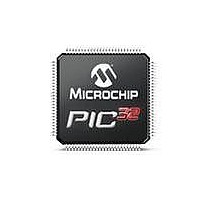PIC32MX775F256H-80V/PT Microchip Technology, PIC32MX775F256H-80V/PT Datasheet - Page 45

PIC32MX775F256H-80V/PT
Manufacturer Part Number
PIC32MX775F256H-80V/PT
Description
256 KB Flash, 64 KB RAM, USB-OTG, Dual CAN, Ethernet, 80 MHz, 10-Bit ADC, DMA 64
Manufacturer
Microchip Technology
Series
PIC® 32MXr
Datasheet
1.PIC32MX575F256H-80VPT.pdf
(256 pages)
Specifications of PIC32MX775F256H-80V/PT
Processor Series
PIC32MX7xx
Core
MIPS
Data Bus Width
32 bit
Program Memory Type
Flash
Program Memory Size
256 KB
Data Ram Size
64 KB
Interface Type
USB, I2C, UART, RS-232, RS-485, SPI
Maximum Clock Frequency
80 MHz
Number Of Programmable I/os
5
Number Of Timers
5
Operating Supply Voltage
2.3 V to 3.6 V
Maximum Operating Temperature
+ 85 C
Mounting Style
SMD/SMT
Package / Case
TQFP-100
Operating Temperature Range
- 40 C to + 85 C
Supply Current (max)
10 mA
Core Processor
MIPS32® M4K™
Core Size
32-Bit
Speed
80MHz
Connectivity
CAN, Ethernet, I²C, SPI, UART/USART, USB OTG
Peripherals
Brown-out Detect/Reset, DMA, POR, PWM, WDT
Number Of I /o
53
Eeprom Size
-
Ram Size
64K x 8
Voltage - Supply (vcc/vdd)
2.3 V ~ 3.6 V
Data Converters
A/D 16x10b
Oscillator Type
Internal
Operating Temperature
-40°C ~ 105°C
Lead Free Status / Rohs Status
Details
Available stocks
Company
Part Number
Manufacturer
Quantity
Price
Company:
Part Number:
PIC32MX775F256H-80V/PT
Manufacturer:
Microchip Technology
Quantity:
10 000
- Current page: 45 of 256
- Download datasheet (6Mb)
2.5
The PGECx and PGEDx pins are used for In-Circuit
Serial Programming™ (ICSP™) and debugging pur-
poses. It is recommended to keep the trace length
between the ICSP connector and the ICSP pins on the
device as short as possible. If the ICSP connector is
expected to experience an ESD event, a series resistor
is recommended, with the value in the range of a few
tens of Ohms, not to exceed 100 Ohms.
Pull-up resistors, series diodes and capacitors on the
PGECx and PGEDx pins are not recommended as they
will interfere with the programmer/debugger communi-
cations to the device. If such discrete components are
an application requirement, they should be removed
from the circuit during programming and debugging.
Alternatively, refer to the AC/DC characteristics and
timing requirements information in the respective
device Flash programming specification for information
on capacitive loading limits and pin input voltage high
(V
Ensure that the “Communication Channel Select” (i.e.,
PGECx/PGEDx pins) programmed into the device
matches the physical connections for the ICSP to
MPLAB
ICE™.
For more information on ICD 2, ICD 3 and REAL ICE
connection requirements, refer to the following
documents that are available on the Microchip web
site.
• “MPLAB
• “Using MPLAB
• “MPLAB
• “Using MPLAB
• “MPLAB
• “MPLAB
• “Using MPLAB
© 2009-2011 Microchip Technology Inc.
IH
Guide” DS51331
Guide” DS51616
DS51749
) and input low (V
®
ICSP Pins
ICD 2, MPLAB
®
®
®
®
ICD 2 In-Circuit Debugger User’s
ICD 2 Design Advisory” DS51566
ICD 3 Design Advisory” DS51764
REAL ICE™ In-Circuit Emulator User’s
®
®
®
ICD 2” (poster) DS51265
ICD 3” (poster) DS51765
REAL ICE™ Emulator” (poster)
IL
) requirements.
®
ICD 3 or MPLAB
®
REAL
PIC32MX5XX/6XX/7XX
2.6
The TMS, TDO, TDI and TCK pins are used for testing
and debugging according to the Joint Test Action
Group (JTAG) standard. It is recommended to keep the
trace length between the JTAG connector and the
JTAG pins on the device as short as possible. If the
JTAG connector is expected to experience an ESD
event, a series resistor is recommended, with the value
in the range of a few tens of Ohms, not to exceed 100
Ohms.
Pull-up resistors, series diodes and capacitors on the
TMS, TDO, TDI and TCK pins are not recommended
as they will interfere with the programmer/debugger
communications to the device. If such discrete compo-
nents are an application requirement, they should be
removed from the circuit during programming and
debugging. Alternatively, refer to the AC/DC character-
istics and timing requirements information in the
respective device Flash programming specification for
information on capacitive loading limits and pin input
voltage high (V
2.7
The trace pins can be connected to a hardware-trace-
enabled programmer to provide a compress real time
instruction trace. When used for trace the TRD3,
TRD2, TRD1, TRD0 and TRCLK pins should be
dedicated for this use. The trace hardware requires
a 22Ω series resistor between the trace pins and the
trace connector.
JTAG
Trace
IH
) and input low (V
IL
) requirements.
DS61156G-page 45
Related parts for PIC32MX775F256H-80V/PT
Image
Part Number
Description
Manufacturer
Datasheet
Request
R

Part Number:
Description:
Manufacturer:
Microchip Technology Inc.
Datasheet:

Part Number:
Description:
Manufacturer:
Microchip Technology Inc.
Datasheet:

Part Number:
Description:
Manufacturer:
Microchip Technology Inc.
Datasheet:

Part Number:
Description:
Manufacturer:
Microchip Technology Inc.
Datasheet:

Part Number:
Description:
Manufacturer:
Microchip Technology Inc.
Datasheet:

Part Number:
Description:
Manufacturer:
Microchip Technology Inc.
Datasheet:

Part Number:
Description:
Manufacturer:
Microchip Technology Inc.
Datasheet:

Part Number:
Description:
Manufacturer:
Microchip Technology Inc.
Datasheet:











